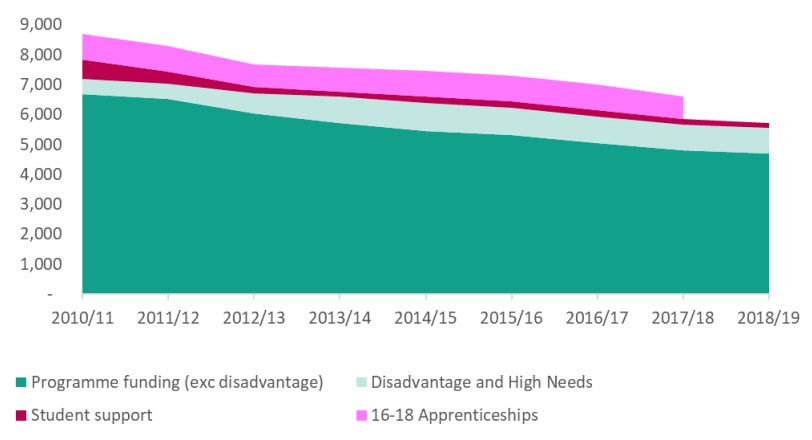Government should urgently review the adequacy of 16-19 funding

Sixth form and college funding declines by 16% in real terms – double the rate of schools.
A new report from the Education Policy Institute (EPI) examines the financial health of sixth forms and colleges in England, revealing the extent of the funding squeeze affecting these institutions.
The report, commissioned by Pearson, considers 16-19 education funding, which includes school sixth forms, sixth form colleges and further education colleges. Compared to other education phases, such as schools (pre-16) and universities, these institutions have consistently received less focus from policy-makers over the last three decades.
Funding levels and the quality of provision in sixth forms and colleges can have a huge impact on life chances. They also affect the vast majority of young people: between the age of 16 and 19, three-quarters of all young people attend these institutions. At present, there are a total of 1.4 million students enrolled in England.
This new report provides the most up to date assessment of funding in these institutions, revealing the latest figures for 2018/19. The research explores the impact on different types of institutions and groups of students across the country. It also considers how funding has affected qualifications, teacher wages and the quality of education on offer.
Total 16-19 Funding by stream, 2010/2011 to 2018/19 (2017/18 for apprenticeships), 2018/19 prices (£m)

Funding trends in sixth forms and colleges
Between 2010/11 and 2018/19, real terms funding per student in school sixth forms, sixth form colleges, and further education (FE) colleges declined substantially, by 16 per cent, from £5,900 to £4,960. This is twice the rate that the overall schools budget fell by between 2009/10 and 2017/18 (8 per cent).
Funding in school sixth forms declined by 26 per cent per full time student from 2010/11 to 2018/19. In the further education sector (sixth form colleges and FE colleges), funding declined by 18 per cent per full time student. Within this, funding for sixth form colleges fell faster than in FE colleges.
Despite funding being shifted towards disadvantaged students over this period, students in all institutions have experienced real terms funding cuts.
16-19 education has been the biggest real terms loser of any phase of education since 2010/11, but it has also suffered from a long run squeeze in funding: 30 years ago, 16-19 funding was far higher (almost 1.5 times) than secondary school funding, but is now lower.
The financial health of 16-19 providers has significantly deteriorated since 2010/11: the proportion of those with in-year deficits has increased across all institutions, with a particularly large rise seen in sixth form colleges: a five-fold increase of 7 to 36 per cent from 2010/2011 to 2016/17.
An increasing number of local authority schools with sixth forms are in financial difficulty – the proportion with cumulative deficits has risen significantly from 12 per cent of schools in 2010/11 to 22 per cent in 2017/18. In stark contrast, schools without sixth forms have only seen rises of 6 per cent to 9 per cent.
Provision in sixth forms and colleges
Students in 16-19 education are receiving fewer hours of learning: learning hours with a teacher for students in all institutions fell by 9 per cent between 2012/13 and 2016/17. The deterioration of 16-19 institutions’ finances may exacerbate these trends further.
This fall in taught hours is particularly prominent in academic subjects: level 3 subjects (A level or equivalent) have seen a sharp decline in hours by 21 per cent between 2012/13 and 2016/17.
For academic subjects, there has been a large decline in AS provision, which has not been offset by rises in the number of hours elsewhere. This may raise concerns about the curriculum becoming even narrower: upper secondary education in England is already narrow compared to leading education nations in the OECD.
Teacher pay in sixth forms and colleges
Teacher pay has fallen across 16-19 institutions, but has declined particularly in further education colleges – by 8 per cent from 2010/11 to 2016/17 (from £33,600 to £31,000).
This means that teacher wages in FE colleges are now around 17 per cent lower than for teachers in secondary schools. This may have implications for the quality of provision, and may adversely affect the most disadvantaged young people, given FE colleges admit a disproportionate number of students from such backgrounds.
Ofsted ratings
There is no clear relationship between the recent funding squeeze and the Ofsted rating of 16-19 providers. However, it remains the case that the Ofsted ratings of FE colleges, on the whole, are less favourable than for schools.
Policy recommendations
The government should urgently review the adequacy of 16-19 funding, to understand whether current funding rates are jeopardising the sector’s financial sustainability.
The government should assess the impact of 16-19 funding changes on curriculum breadth, ensuring that young people have a good choice of high quality post-16 academic and vocational qualifications.
The government should review the impact of funding changes on disadvantaged students and consider whether funding is supporting the government’s aim of narrowing the attainment gap.
Sector Response
Gerard Dominguez-Reig, Senior Researcher at the Education Policy Institute (EPI), said:
“While it is widely acknowledged that schools are facing growing funding pressures, our research shows that the financial health of sixth forms and colleges is particularly precarious.
“The sharp, real terms decline in funding over nine years has led to larger deficits in 16-19 education institutions, and has taken place alongside a substantial fall in student learning hours, with declines of over 20 per cent in academic subjects.”
Chris Keates, General Secretary of the NASUWT-The Teachers’ Union, said:
“The NASUWT has been warning for some time that much of the post-16 sector is in a parlous financial state because of Government cuts and a lack of scrutiny of how money is being spent.
“Cuts have been made to per student funding and teachers’ pay and the result has been a reduction in students’ learning hours since 2012.
“In addition, the increasing costs and ongoing funding inequalities are reducing the learning opportunities for young people, narrowing the range of subjects and courses colleges are able to offer and are leading to the loss of life-changing opportunities for students.This is economically short sighted. High quality post-16 provision is critical to ensuring young people have the skills to meet changing and global economic needs.
“The current funding arrangements for colleges and sixth forms are inadequate, allowing for the retention of high levels of reserves at individual school and college levels at the same time as cutting per student funding.
“The NASUWT will continue to campaign for a substantial above inflation pay increase for sixth form college teachers, for above inflation increases in post-16 funding during the next Spending Review period and for a funding regime which ensures that post-16 funding is used appropriately.”
Rt. Hon David Laws, Executive Chairman of the Education Policy Institute (EPI), said:
“This research shows that for many decades, sixth form and college funding has been the big loser relative to other phases of education. Since 2010, sixth form funding per student has been cut by 16 per cent – double the 8 per cent decline across all school spending.
“It is not clear why successive governments have chosen to squeeze 16-19 funding, and there is a strong case for reviewing the adequacy of funding before the upcoming Spending Review. The government should also consider if enough is being done to support disadvantaged students, who are disproportionately concentrated in FE colleges, where teacher pay is significantly lower than that in school sixth forms.”
 Rod Bristow, President (UK and Core) of Pearson, said:
Rod Bristow, President (UK and Core) of Pearson, said:
“The EPI report makes plain that our schools and colleges have been struggling against the tide of decreasing funding levels by narrowing choices. This phase of learning has a big impact on social mobility and people’s life chances. We should use this opportunity to encourage a step change, to clarify the 16-19 pathways that offer the best return for young people, and offer young people choices that expand their horizons and improve their lives.”
A Department for Education spokesperson said:
“We recognise that 16 to 19 funding rates are challenging for all providers at the moment and are looking carefully at this in the run-up to the next Spending Review. Our school sixth forms and colleges have a vital role to play in making sure people have the skills they need to get on in life.
“That is why we have protected the base rate of funding for 16 to 19 year olds until 2020. We continue to allocate further funding for specific needs such as an extra £500m for providers to support disadvantaged students. We will also be providing an additional £500m every year, for the delivery of the new gold standard T levels once they are fully rolled out.
“Our commitment to the 16 to 19 sector has contributed to the current record high proportion of 16 and 17 year olds who are participating in education or apprenticeships, the highest since consistent records began.
“This year, we are providing additional funding to support institutions to increase participation in advanced maths qualifications – this means that sixth forms will receive £600 for every additional student studying AS or A Level Maths or Core Maths.
“Nearly £60 million additional funding has already been allocated to providers to help them build capacity for the improved industry placements that will form part of the new T levels.”
 David Hughes, Chief Executive of the Association of Colleges, said:
David Hughes, Chief Executive of the Association of Colleges, said:
“Report after report and expert after expert have highlighted the impact of the decade of cuts that England’s colleges have had to endure. EPI are the latest independent voice to point this out, and the evidence is consistent.
“Cuts to college funding have meant that:
- students in England receive an average of ten hours less teaching time per week than their counterparts in other OECD countries – that’s 300 fewer hours each year. This disparity will impact our ability to compete as we look to sure up our economy post-Brexit
- teaching staff in colleges are now paid an average of £7k less than in schools – making the recruitment and retention crisis across the wider-sector even more stark in further education
- increased pressure on the financial viability of institutions – according to a report by the Children’s Commissioner, by the end of this decade, we’ll be spending the same amount of money per 16-18 student as we were in 1990, despite costs rising with inflation. This has consequences.
“Association of Colleges has long been calling for an end to ten years of cuts, and for 16-19 funding to be prioritised in the upcoming Comprehensive Spending Review. We’ve recently seen MPs from all major parties lend their backing – including 165 MPs signing a letter to the Chancellor, co-authored by prominent Conservative and Labour MPs, and almost 100 MPs speaking in two Westminster Hall Debates in the last six months.
“This issue goes way beyond Westminster though. The #LoveOurColleges campaign shows that there is backing from a broad coalition across the country, including businesses and employers, unions, students, and the general public.
“The message is clear; the Chancellor cannot go on ignoring the overwhelming independent evidence consistently presented to him. If he is serious about supporting our economy and our communities, he has to get serious about investing in our colleges.”
 Kevin Courtney, Joint General Secretary of the National Education Union, said:
Kevin Courtney, Joint General Secretary of the National Education Union, said:
“This comprehensive and important report exposes the reality of Government cuts to 16-19 education, which now amount to a real-terms cut of 24% since 2010. The consequences are dire, with the number of teaching hours students receive falling by an average of 65 hours per year over just 4 years.
“All subjects are important but it is striking that the largest cut in teaching hours was for science and maths, which runs counter to stated Government policy. The report also shows that the cuts have fallen hardest on the most deprived students.
“The Government must act to reverse this as a matter of urgency. It is clearly wrong that 16-19 students receive less funding than secondary students and less than half the amount spent on higher education. The current situation is unsustainable and must be addressed immediately.”
Methodology: 16-19 education in England includes school sixth forms, sixth form colleges, and further education colleges. Students up until the age of 19 are included in this study as many vocational courses last three years. Data for this age range is also collected by the DfE.
The analysis builds on research by the Institute for Fiscal Studies (IFS) published in 2018. The research found that total school spending per pupil had fallen by 8% in real terms between 2009–10 and 2017–18.
Cumulative balances consider balances over time, and whether institutions are in surplus or deficit. (Data for local authority sixth forms only). In-year balances (all institutions) examine income and expenditure for a given year only and whether institutions are spending more money than they have coming in for that year.











Responses